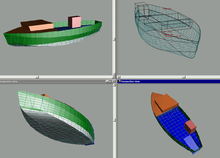Phil Bolger
He subsequently designed more than 668 different boats,[1] from a 114-foot-10-inch (35 m) replica of an eighteenth-century naval warship, the frigate Surprise (ex-Rose), to the 6-foot-5-inch (1.96 m) plywood box-like dinghy Tortoise.
A subclass of these designed in association with Harold Payson called Instant Boats were so named because they were intended to be easily built by amateurs out of commonly available materials.
[4] As far back as 1957 he designed "Poohsticks" [5] as a small plywood rowing skiff to be simply and economically built at home (originally by his brother).
From this simple start he went on to develop a large number of designs for small- and medium-sized craft using plywood as a material for one-off construction at home or by small boatyards.
This results in quick construction and less requirement for skilled craftsmanship, and has proved appealing to amateur boat builders as well as many later designers who have followed in his footsteps, albeit much less prolifically.
The book described all the basic techniques (gluing, nailing and screwing with some fiberglass) to produce five designs: 12' Teal, 7'9" Elegant Punt, 12' Kayak, 31' Folding Schooner, 15'6" Surf, and 20'9" Zephyr.
The book includes plans for Gypsy (15' sail/oar/outboard), Nymph (7'9" dinghy with sail option), Diablo (15' motor boat for up to 25 HP outboard) as well as 8 more "traditional instant boats" using the chine log method: 16' Lug-rigger Windsprint, 6'5" Tortoise, 8' Skimmer, Dynamite Sailboard, 16'June Bug, Madeline a 19'6" Pedal-driven sidewheeler and the 23'6" Light Schooner.
Power sharpies can use low-horsepower motors (see, for example, the Bolger Tennessee, Idaho, and Sneakeasy designs) yet reach planing speeds in sheltered waters.
Major critics of sharpies point to the fact that they tend to pound under certain conditions and that the relatively shallow draft makes them unseaworthy.
Their advocates (including Bolger) point to the fact that they are exceptionally good boats for their cost, make excellent day boats and are increasingly seaworthy as (i) the length to beam ratio increases, (ii) they are adequately ballasted and (iii) they are given reserve stability and/or made watertight sufficiently to ensure that they self-right in the event of a capsize.
Bolger reasoned that a simple rockered bottom and vertical sides gives the most volume, and form stability, on a given beam.
Later in his career Phil Bolger and Friends developed modifications to the simple sharpie bow to avoid hull slap at anchor at the expense of a much more complex geometry.
In some designs an open bow can allow passage to land if the boat is beached, space for holding anchors and cables, or clearance to step and unstep a mast.
He concluded that a single leeboard is sufficient in many cases on small boats, and that rigs could be stepped off the centerline without much effect on performance.
His comments on each subject in books as well as articles published in magazines of the period are based on his research, analysis, first hand experience and use of the different configurations.
Beginning in November 2002, Bolger and Altenberger began a re-examination of fisheries economics, as a result of the partial collapse of the industry both globally and locally in their hometown of Gloucester, Massachusetts.
Most modern vessels are horsepower intensive concepts with often oversized drive trains that cost extra in terms of hardware, operation, repair and replacement.


